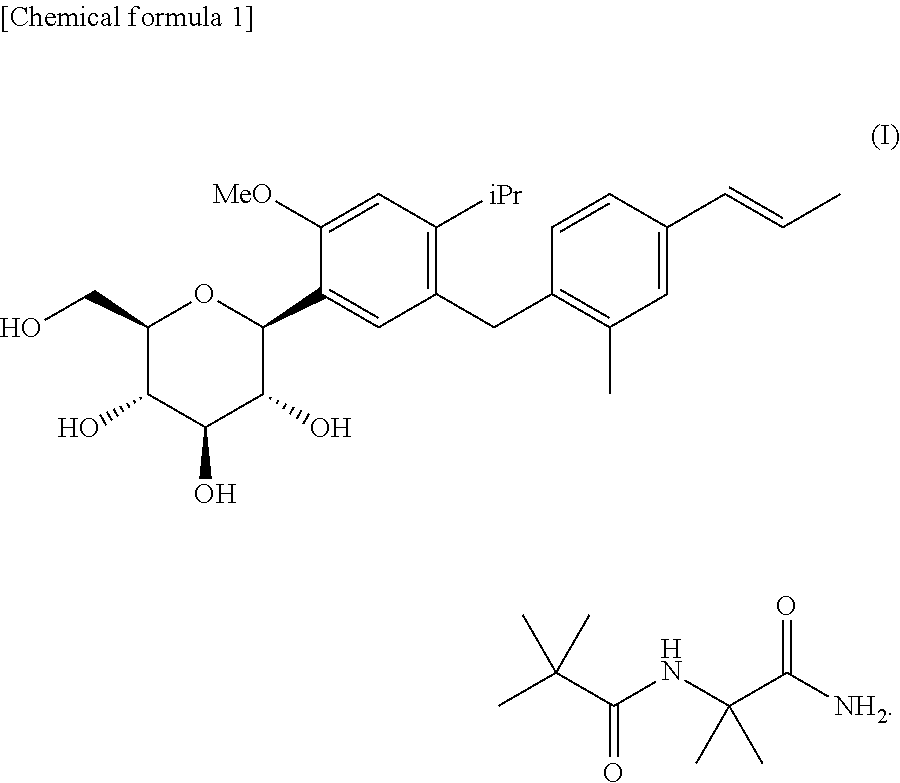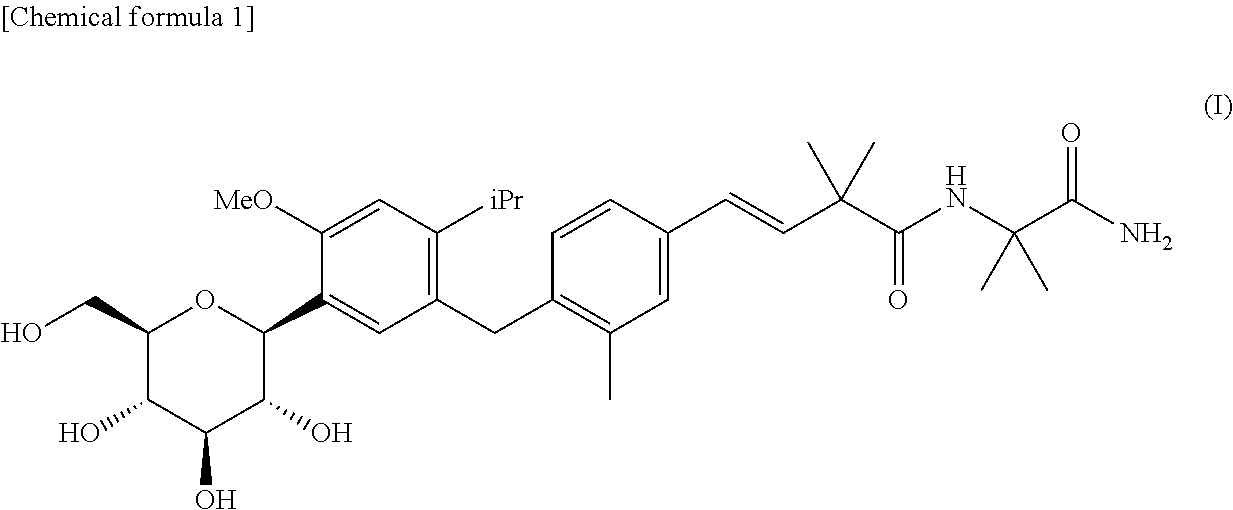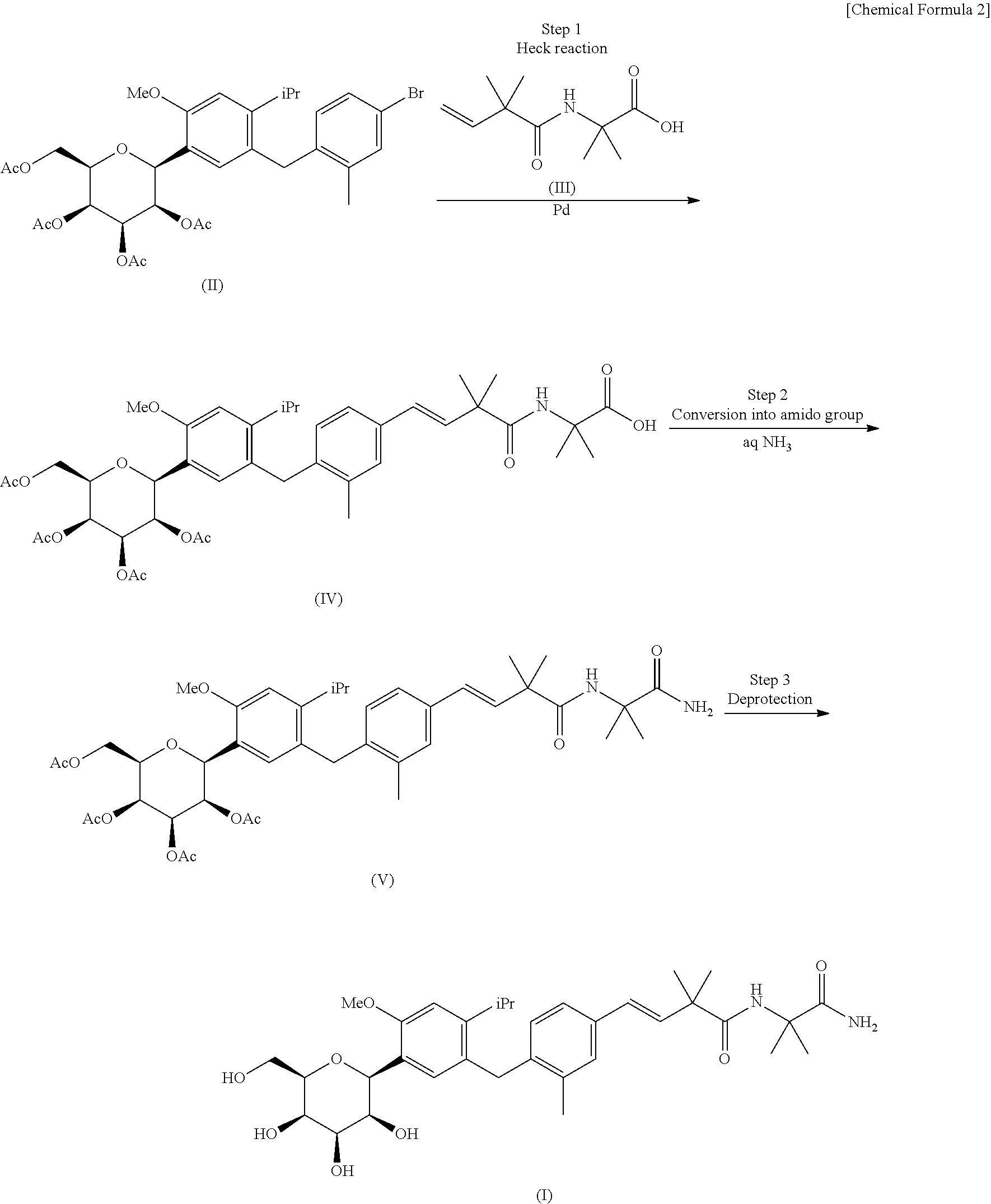4-isopropyl-6-methoxyphenyl glucitol compound
a technology of phenyl glucitol and isopropyl glucitol, which is applied in the direction of sugar derivates, drug compositions, metabolic disorders, etc., can solve the problems of increased risk of cardiovascular disorders, unexpected toxicity and side effects, and impaired glucose tolerance, and achieve the effect of inhibiting sglt1 activity
- Summary
- Abstract
- Description
- Claims
- Application Information
AI Technical Summary
Benefits of technology
Problems solved by technology
Method used
Image
Examples
reference example 1
Production of Intermediate (A)
[0106]
[0107](1) Step 1 Compound (A1)
[0108]
[0109]To a solution of 3-isopropylphenol (25.0 g, 0.184 mol) in acetic acid (200 mL), a suspension of potassium iodate (7.88 g, 0.0368 mol) in water (75 mL) and iodine (18.7 g, 0.0736 mol) were added. This reaction mixture was stirred at room temperature for 20 hours. After addition of diethyl ether (400 mL) and water (300 mL), the organic layer was separated. The organic layer was washed with water, a saturated aqueous solution of sodium hydrogen carbonate and brine, and then dried over anhydrous magnesium sulfate. After filtering off the desiccant, the solvent was distilled off under reduced pressure. The resulting residue was purified by silica gel column chromatography (hexane:ethyl acetate=95:5) to give 2-iodo-5-isopropylphenol (27.6 g, 57%) as a colorless oil.
[0110]1H NMR (200 MHz, CHLOROFORM-d) δ ppm 1.16-1.25 (m, 6 H) 2.64-2.98 (m, 1 H) 5.21 (s, 1 H) 6.57 (dd, J=8.13, 2.20 Hz, 1 H) 6.88 (d, J=2.20 Hz, 1 ...
reference example 2
Production of Intermediate (A)
[0150]To a solution of 3-isopropylphenol (160 g, 1.18 mol) in acetic acid (1.6 L), a solution of bromine (469 g, 2.94 mol) in acetic acid (320 mL) was added dropwise over 32 minutes, under ice cooling such that the internal temperature did not exceed 19° C., and the mixture was stirred at room temperature for 1 hour. After addition of toluene (1.6 L), the mixture was cooled on ice. A 10% aqueous solution of sodium sulfite (1.0 L) was added dropwise such that the internal temperature did not exceed 20° C., to separate the organic layer. The organic layer was washed twice with a 10% aqueous solution of sodium sulfite (1.0 L) and a 10% aqueous solution of sodium chloride (1.0 L), and then dried over anhydrous magnesium sulfate. After filtering off the desiccant, the solvent was distilled off under reduced pressure to give 2,4-dibromo-5-isopropylphenol (342 g, 99%) as a light yellow oil.
[0151]1H NMR (300 MHz, CHLOROFORM-d) δ ppm 1.21 (d, J=6.84 Hz, 6 H) 3.2...
reference example 3
Production of Intermediate (B)
[0162]
[0163](1) Step 1 Compound (B1)
[0164]
[0165]To a solution of 2,2-dimethyl-3-butenoic acid (J. Org. Chem., Vol. 65, p. 8402, 2000) (5.42 g, 47.5 mmol) in chloroform (250 mL), oxalyl chloride (4.43 mL, 49.9 mmol) and N,N-dimethylformamide (3 drops) were added under a nitrogen atmosphere, and the mixture was stirred at room temperature for 1.5 hours. Then, the reaction mixture was cooled on ice, and triethylamine (19.9 mL, 143 mmol) and α-aminoisobutyric acid methyl ester hydrochloride (10.9 g, 71.2 mmol) were added, followed by stirring the mixture at room temperature for 1 hour. Water was added to the reaction mixture, and the resulting mixture was extracted with chloroform. Then, the organic layer was washed with 3M hydrochloric acid, a saturated aqueous solution of sodium hydrogen carbonate and brine, and dried over anhydrous magnesium sulfate. After filtering off the desiccant, the solvent was distilled off under reduced pressure. The resulting re...
PUM
| Property | Measurement | Unit |
|---|---|---|
| temperature | aaaaa | aaaaa |
| temperature | aaaaa | aaaaa |
| temperature | aaaaa | aaaaa |
Abstract
Description
Claims
Application Information
 Login to View More
Login to View More - R&D
- Intellectual Property
- Life Sciences
- Materials
- Tech Scout
- Unparalleled Data Quality
- Higher Quality Content
- 60% Fewer Hallucinations
Browse by: Latest US Patents, China's latest patents, Technical Efficacy Thesaurus, Application Domain, Technology Topic, Popular Technical Reports.
© 2025 PatSnap. All rights reserved.Legal|Privacy policy|Modern Slavery Act Transparency Statement|Sitemap|About US| Contact US: help@patsnap.com



